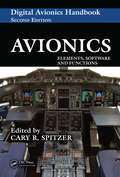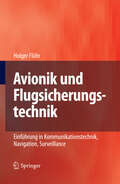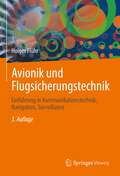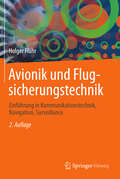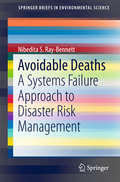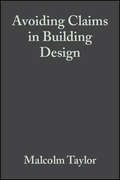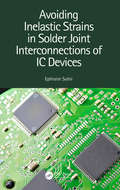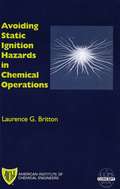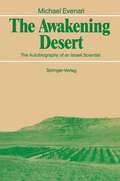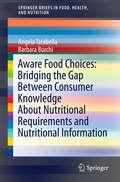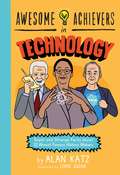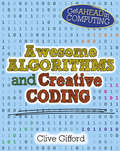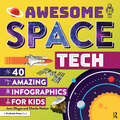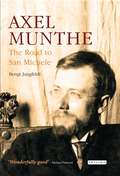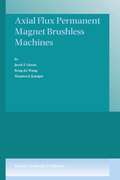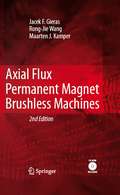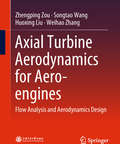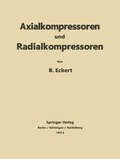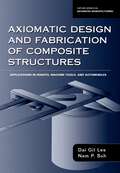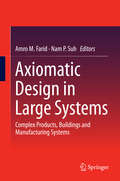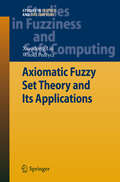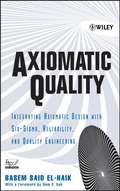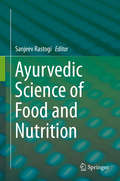- Table View
- List View
Avionics: Elements, Software and Functions (The Avionics Handbook, Second Edition)
by Cary R. SpitzerRenamed to reflect the increased role of digital electronics in modern flight control systems, Cary Spitzer's industry-standard Digital Avionics Handbook, Second Edition is available in two comprehensive volumes designed to provide focused coverage for specialists working in different areas of avionics development. The first installment, Avionics: Elements, Software, and Functions covers the building blocks and enabling technologies behind modern avionics systems. It discusses data buses, displays, human factors, standards, and flight systems in detail and includes new chapters on the Time-Triggered Protocol (TTP), ARINC specification 653, communications, and vehicle health management systems.
Avionik und Flugsicherungstechnik: Einführung in Kommunikationstechnik, Navigation, Surveillance
by Holger FlührDas Lehrbuch spannt den Bogen von Flugsicherungs-Technologien über Avioniksysteme (Kommunikation, Navigation, Surveillance) sowie die bordautonome Energieversorgung bis hin zur Integration der Systeme im Flugzeug. Neben der Beschreibung von Funktion und Aufbau der Teilsysteme behandelt der Autor deren Einbindung in die Avionikumgebung des Flugzeugs und die Bodeninfrastruktur. Notwendiges nachrichtentechnisches Wissen wird wiederholt, die Definition von Lernzielen, Verständnisfragen und beispielhafte Aufgaben sichern den Lernerfolg.
Avionik und Flugsicherungstechnik: Einführung in Kommunikationstechnik, Navigation, Surveillance
by Holger FlührDas Buch spannt den Bogen von modernen Technologien zur Flugsicherung über die wesentlichen Avioniksysteme (Kommunikation, Navigation, Surveillance) sowie die bordautonome Energieversorgung bis hin zur Integration der Systeme im Flugzeug. Der Autor legt Wert auf die Einbindung der vorgestellten Funktionsblöcke in das System Flugzeug bzw. in das System Luftfahrt: Er behandelt sowohl Funktion und Aufbau der Teilsysteme als auch deren Einbindung in die Avionikumgebung des Flugzeugs und in die Bodeninfrastruktur. Ein weiteres Thema sind zulassungsspezifische Fragestellungen. Zum Verständnis notwendige nachrichtentechnische Kenntnisse werden komprimiert wiederholt. Der Lernerfolg wird durch Definition von Lernzielen, Verständnisfragen und Beispielaufgaben sichergestellt. Die 2., komplett durchgesehene Auflage erweitert vor allem die Ausführungen zur Zuverlässigkeit von Flugzeugsystemen und lässt aktuelle Entwicklungen wie etwa SESAR in den Text einfließen.
Avionik und Flugsicherungstechnik: Einführung in Kommunikationstechnik, Navigation, Surveillance
by Holger FlührDas Buch spannt den Bogen von modernen Technologien zur Flugsicherung über die wesentlichen Avioniksysteme (Kommunikation, Navigation, Surveillance) sowie die bordautonome Energieversorgung bis hin zur Integration der Systeme im Flugzeug. Der Autor legt Wert auf die Einbindung der vorgestellten Funktionsblöcke in das System Flugzeug bzw. in das System Luftfahrt: Er behandelt sowohl Funktion und Aufbau der Teilsysteme als auch deren Einbindung in die Avionikumgebung des Flugzeugs und in die Bodeninfrastruktur. Ein weiteres Thema sind zulassungsspezifische Fragestellungen. Zum Verständnis notwendige nachrichtentechnische Kenntnisse werden komprimiert wiederholt. Der Lernerfolg wird durch Definition von Lernzielen, Verständnisfragen und Beispielaufgaben sichergestellt. Die 2., komplett durchgesehene Auflage erweitert vor allem die Ausführungen zur Zuverlässigkeit von Flugzeugsystemen und lässt aktuelle Entwicklungen wie etwa SESAR in den Text einfließen.
Avoidable Deaths: A Systems Failure Approach to Disaster Risk Management (SpringerBriefs in Environmental Science)
by Nibedita S. Ray-BennettThis book addresses one of the most fundamental questions of the 21st century: why deaths continue to occur in natural disasters despite the tremendous advancements in disaster management science and weather forecasting systems, increased sophistication of human-built environments and ongoing economic and policy development worldwide. By presenting an interdisciplinary tool for analysing ‘systems failure’, the book provides concrete suggestions on how deaths may be reduced in resource-poor contexts. It goes beyond traditional risk and vulnerability perspectives and demonstrates that deaths in disasters are complex problems that can be solved by adopting a socio-technical perspective to improve current disaster management systems in the developing world. The book is a timely contribution, as it directly addresses Global Target One of the UN’s ‘Sendai Framework for Disaster Risk Reduction’, which has urged 185 UN Member States to reduce disaster mortality by 2030. Further, it offers a valuable resource for students, researchers, policy-makers and practitioners interested in disaster risk reduction, human rights, gender, sociology of risk, crisis and disasters, environmental science, organisation and management studies.
Avoiding Claims in Building Design: Risk Management in Practice
by Malcolm TaylorThe chance of being claimed against is now a major risk factor for every building designer, engineer, quantity surveyor and project manager. Apart from the cases that go to court, many other claims are settled before they reach that stage. The cost of insurance to meet claims is now a substantial component of every practice's overheads. Sensible risk management can identify the potential sources of claims, reduce their likelihood, warn of impending trouble and control how the claim is to be defended. This book explains how to plan a risk management strategy and suggests techniques that can supplement the practice's existing management procedures without imposing unnecessary bureaucracy. It attaches as much importance to the interaction of risk between members of the design team as to the risk profile of the practice itself. The first part defines risk and its origins, discusses how risk can arise in the various professions and types of practice, and how it interacts between the professions, compares quality assurance with risk management, and advises on the relations between the practice, its insurers and its lawyers. It concludes with advice on how to create a risk strategy and system for the office. The second part is devoted to techniques and covers: setting up the appointment; creation of the team; managing the project; the risks of CDM; the complications of procurement; and drafting, awarding and administering the building contract. Risk implications of the major contract forms are discussed in detail. It concludes with advice on the handling of claims. The book contains references to a number of legal cases to illustrate the risks discussed. It is recommended reading not only for the individual professions (architect, engineer, QS, project manger), but for all of them collectively in understanding how the risk of one profession can become the risk of any of his fellow team members.
Avoiding Inelastic Strains in Solder Joint Interconnections of IC Devices
by Ephraim SuhirAvoiding Inelastic Strains in Solder Joint Interconnections of IC Devices addresses analytical (mathematical) modeling approaches aimed at understanding the underlying physics and mechanics of the behavior and performance of solder materials and solder joint interconnections of IC devices. The emphasis is on design for reliability, including probabilistic predictions of the solder lifetime. Describes how to use the developed methods of analytical predictive modeling to minimize thermal stresses and strains in solder joint of IC devices Shows how to build the preprocessing models in finite-element analyses (FEA) by comparing the FEA and analytical data Covers how to design the most effective test vehicles for testing solder joints Details how to design and organize, in addition to or sometimes even instead of highly accelerated life tests (HALT), highly focused and highly cost-effective failure oriented accelerated testing (FOAT) to understand the physic of failure of solder joint interconnections Outlines how to convert the low cycle fatigue conditions into elastic fatigue conditions and to assess the fatigue lifetime in such cases Illustrates ways to replace time- and labor-consuming, expensive, and possibly misleading temperature cycling tests with simpler and physically meaningful accelerated tests This book is aimed towards professionals in electronic and photonic packaging, electronic and optical materials, materials engineering, and mechanical design.
Avoiding Static Ignition Hazards in Chemical Operations: A CCPS Concept Book (A CCPS Concept Book #20)
by Laurence G. BrittonWritten by Laurence Britton, who has over 20 years' experience in the fields of static ignition and process fire and explosion hazards research, this resource addresses an area not extensively covered in process safety standards or literature: understanding and reducing potential hazards associated with static electricity. The book covers the nature of static electricity, characteristics and effective energies of different static resources, techniques for evaluating static electricity hazards, general bonding, grounding, and other techniques used to control static or prevent ignition, gases and liquids, powders and hybrid mixtures.
The Awakening Desert: The Autobiography of an Israeli Scientist
by Michael EvenariMichael Evenari's biography unfolds his exciting, manifold life: his love for botany, the confrontation with political events as a youngster and his thrilling experience of helping in the development of Israel. Evenari takes us on his exciting expeditions in the company of his beloved wife. He tells us of his meetings with many personalities and about his farm in the Negev. The discovery of long forgotten floodwater irrigated farm systems from the times of King Salomon and their reconstruction became a successful experiment which lead him to teach this approach of runoff agriculture in many parts of the world, initializing progress in the development of various arid areas. As a tribute to his successful scientific life, Evenari was awarded the Balzan Prize in 1988. In April 1989, Michael Evenari died at the age of 84.
Aware Food Choices: Bridging the Gap Between Consumer Knowledge About Nutritional Requirements and Nutritional Information (SpringerBriefs in Food, Health, and Nutrition)
by Angela Tarabella Barbara BurchiThis Brief provides a snapshot of the continuing debate in the food industry on how to bridge the gap between consumer knowledge of nutrition principles and the nutrition information system currently in place for labelling. Aware Food Choices: Bridging the Gap Between Consumer Knowledge About Nutrition and Nutritional Information examines the available literature on consumer understanding of nutritional information and comments on the current poor knowledge shown by consumers about nutrition principles. Another focus of this Brief is on the evolution of nutritional information in food labelling andcurrent regulations on nutritional claims and product facts. In reviewing attempts to improve the nutrition information system, this work points out that consumers must first understand the data provided in order to utilize the system to make healthy food choices. Therefore, any campaigns aimed at improving the information system must concentrate on consumer data understanding of nutrition principles and components as opposed to a sole focus on labelling upgrades.
Awesome Achievers in Technology: Super and Strange Facts about 12 Almost Famous History Makers (Awesome Achievers)
by Alan KatzPart of a super fun middle grade series, Awesome Achievers in Technology puts the spotlight on lesser-known heroes and their contributions in tech.Everyone has heard the name Steve Jobs, but what about Nolan Bushnell--Jobs's boss before the invention of Apple, and the founder of the first major video game, Pong? Many of the most relevant figures in tech history have remained in the shadows, but not any longer! From Alan Katz's new Awesome Achievers series, Awesome Achievers in Technology gives kids a look behind the scenes at 12 lesser-known inventors whose contributions to tech are personally relevant to their lives today. Each figure is given a traditional biography but is also subject to Katz's unique brand of silliness, with humorous elements such as imagined poems, song lyrics, and diary entries by and about the not-so-famous figure accompanying each bio. Spot illustrations throughout add to the lighthearted and appreciative humor each figure receives. Reluctant readers and budding tech enthusiasts alike will delight in this imaginative and engaging introduction to a new series of laugh out loud biographies.
Awesome Algorithms & Creative Coding (Get Ahead in Computing #2)
by Clive GiffordAwesome Algorithms and Creative Coding explores how computers work and explains how to think in a logical way. The bright and engaging design guides readers through clear explanations of binary code, simple algorithms and computer language. With real-life examples readers learn about the development of coding using simple decision making processes. Looks at programming languages that readers can use themselves, including Scratch and LOGO. Stretch Yourself features give practical activities to help readers explore and test key principles. These 'try at home' examples help reinforce learning and are not linked to specific software or operating systems. True Story features give real-world anecdotes from the world of information technology. Computer Hero features look at the forerunners of digital technology that have paved the way for scientists today.Get Ahead in Computing is a practical and much-needed resource for the KS1-2 computing curriculum exploring all aspects of computational thinking. The series breaks down this new curriculum subject into four titles covering key topics: computer science, algorithms & coding, applications & programs, and computer networks.Ideal for young readers starting the new Computing curriculum subject in school.Other titles in the Get Ahead in Computing series: The Science of Computers, Amazing Applications & Perfect Programs, and Computer Networks.
Awesome Space Tech: 40 Amazing Infographics for Kids
by Jennifer Dlugos Charlie HattonSpace may be the "final frontier"—but how do we learn about it, look deeper into it, and live in it? The infographics in this book will rocket you through a universe of powerful telescopes, distant probes, and high-speed spacecraft. Get ready to buzz by comets, land on alien planets, peer into the universe's past, and go where no one (except a handful of rovers and space probes) has gone before! We live in a complicated cosmos, but this book breaks down the complex, the confusing, and the downright kooky to reveal the fascinating details and hidden wonders that are out of this world.Ages 9-12
Awesome Space Tech: 40 Amazing Infographics for Kids
by Jennifer Dlugos Charlie HattonSpace may be the "final frontier"—but how do we learn about it, look deeper into it, and live in it? The infographics in this book will rocket you through a universe of powerful telescopes, distant probes, and high-speed spacecraft. Get ready to buzz by comets, land on alien planets, peer into the universe's past, and go where no one (except a handful of rovers and space probes) has gone before! We live in a complicated cosmos, but this book breaks down the complex, the confusing, and the downright kooky to reveal the fascinating details and hidden wonders that are out of this world.Ages 9-12
Axel Munthe: The Road to San Michele
by Bengt JangfeldtAxel Munthe: The Road to San Michele' tells for the first time the riveting life-story of an extraordinary individual, who came to define the times he lived in. The precociously bright son of a Swedish pharmacist, Axel Munthe worked under Jean Martin Charcot, and in 1880, became the youngest doctor in French history. By the 1890s, he was world-famous for his healing powers, believed by some to be supernatural. He moved in the most colourful and exalted circles of fin de siecle Europe, counting amongst his friends Henry James, Howard Carter, Rainer Maria Rilke, Lady Ottoline Morrell and Count Zeppelin. Though physician to the Swedish court, where he became the lover of the Crown Princess Victoria, Munthe was more at home with nature than with people. He travelled through remotest Lapland, as well as across Europe, and his great love was animals, whom he went to great lengths to protect. In 1929 he published 'The Story of San Michele', an account of his life, shot through with his love for Italy and Capri, where he built a bird sanctuary and the house of his dreams, the Villa San Michele. The book became an international best seller, translated into 40 languages, and has become one of the classics of the last century. Bengt Jangfeldt is the first person to have gone through Munthe's diaries, letters and notebooks to produce this definitive account of one of 20th Century Europe's most vibrant figures. Written with the verve and exuberance of its subject, 'Axel Munthe: The Road to San Michele' evokes a lost time, a life of passions, and a man who believed in every sense in the power of dreams.
Axial Flux Permanent Magnet Brushless Machines
by Jacek F. Gieras Rong-Jie Wang Maarten J. KamperAxial Flux Permanent Magnet (AFPM) brushless machines are modern electrical machines with a lot of advantageous merits over their conventional counterparts. They are increasingly used in power generation, domestic appliances, industrial drives, electric vehicles, and marine propulsion drives and many other applications. This book deals with the analysis, construction, design, optimisation, control and applications of AFPM machines. The authors present their own research results, as well as significant research contributions made by others. This monograph will be of interest to electrical engineers and other engineers involved in the design and application of AFPM brushless machine drives. It will be an important resource for researchers and graduate students in the field of electrical machine and drives.
Axial Flux Permanent Magnet Brushless Machines
by Jacek F. Gieras Rong-Jie Wang Maarten J. KamperAxial Flux Permanent Magnet (AFPM) brushless machines are modern electrical machines with a lot of advantages over their conventional counterparts. This timeless and revised second edition deals with the analysis, construction, design, control and applications of AFPM machines. The authors present their own research results, as well as significant research contributions made by others.
Axial Turbine Aerodynamics for Aero-engines: Flow Analysis and Aerodynamics Design
by Zhengping Zou Songtao Wang Huoxing Liu Weihao ZhangThis book is a monograph on aerodynamics of aero-engine gas turbines focusing on the new progresses on flow mechanism and design methods in the recent 20 years. Starting with basic principles in aerodynamics and thermodynamics, this book systematically expounds the recent research on mechanisms of flows in axial gas turbines, including high pressure and low pressure turbines, inter-turbine ducts and turbine rear frame ducts, and introduces the classical and innovative numerical evaluation methods in different dimensions. This book also summarizes the latest research achievements in the field of gas turbine aerodynamic design and flow control, and the multidisciplinary conjugate problems involved with gas turbines. This book should be helpful for scientific and technical staffs, college teachers, graduate students, and senior college students, who are involved in research and design of gas turbines.
Axialkompressoren und Radialkompressoren: Anwendung / Theorie / Berechnung
by Bruno EckertIn den vergangenen zwei Jahrzehnten hat sich, vor allem angeregt durch die neuen Erkennt nisse und Fortschritte der Aero-und Hydrodynamik, auf dem Gebiet der Turbomaschinen eine beschleunigte Entwicklung vollzogen. Das Prinzip der Turbomaschine beruht auf der dynamischen Energieübertragung. Im Gegen satz zum statischen Prinzip, das die Grundlage der Kolbenmaschine darstellt, ermöglicht das dynamische Prinzip eine bedeutende Steigerung der Leistungsdichte, da die hierbei möglichen hohen Umfangs-und Durchströmgeschwindigkeiten das Verarbeiten großer Leistungen bei be scheidenem Raum- und Werkstoffbedarf gestatten. Eine zweite Tatsache, die den Aufschwung der Turbo- oder Strömungsmaschine förderte, ist die günstige Energieumsetzung dieser Maschinenart. Die großen Fortschritte in dieser Hinsicht, d. h. die erreichte Steigerung des Wirkungsgrades, sind der Erfolg einer theoretischen Durch dringung der Materie, vor allem aber sind sie die Früchte einer planmäßigen Zweckforschung. Steigerung der Leistungsdichte und Verbesserung der Wirkungsgrade der Strömungsmaschinen waren neben den Fortschritten auf metallurgischem Gebiet auch die Voraussetzungen für die im Laufe der letzten fünfzehn Jahre erfolgte Entwicklung der Gasturbine zur wettbewerbsfähigen Wärmekraftmaschine. Das vorliegende Buch befaßt sich nur mit einem Teil der Turbomaschinen, und zwar mit Turbokompressoren der axialen und radialen Bauart und ist in folgende Hauptteile gegliedert: Kapitel A enthält Richtlinien zur Festlegung der Auslegungskenngrößen von Kompressoren.
Axiomatic Design and Fabrication of Composite Structures: Applications in Robots, Machine Tools, and Automobiles (Oxford Series on Advanced Manufacturing)
by Dai Gil Lee Nam Pyo SuhThe idea that materials can be designed to satisfy specific performance requirements is relatively new. With high-performance composites, however, the entire process of designing and fabricating a part can be worked out before manufacturing. The purpose of this book is to present an integrated approach to the design and manufacturing of products from advanced composites. It shows how the basic behavior of composites and their constitutive relationships can be used during the design stage, which minimizes the complexity of manufacturing composite parts and reduces the repetitive "design-build-test" cycle. Designing it right the first time is going to determine the competitiveness of a company, the reliability of the part, the robustness of fabrication processes, and ultimately, the cost and development time of composite parts. Most of all, it should expand the use of advanced composite parts in fields that use composites only to a limited extent at this time. To achieve these goals, this book presents the design and fabrication of novel composite parts made for machine tools and other applications like robots and automobiles. This book is suitable as a textbook for graduate courses in the design and fabrication of composites. It will also be of interest to practicing engineers learning about composites and axiomatic design. A CD-ROM is included in every copy of the book, containing Axiomatic CLPT software. This program, developed by the authors, will assist readers in calculating material properties from the microstructure of the composite. This book is part of the Oxford Series on Advanced Manufacturing.
Axiomatic Design in Large Systems: Complex Products, Buildings and Manufacturing Systems
by Amro M. Farid Nam P. SuhThis book provides a synthesis of recent developments in Axiomatic Design theory and its application in large complex systems. Introductory chapters provide concise tutorial materials for graduate students and new practitioners, presenting the fundamentals of Axiomatic Design and relating its key concepts to those of model-based systems engineering. A mathematical exposition of design axioms is also provided.The main body of the book, which represents a concentrated treatment of several applications, is divided into three parts covering work on: complex products; buildings; and manufacturing systems.The book shows how design work in these areas can benefit from the scientific and systematic underpinning provided by Axiomatic Design, and in so doing effectively combines the state of the art in design research with practice. All contributions were written by an international group of leading proponents of Axiomatic Design. The book concludes with a call to action motivating further research into the engineering design of large complex systems.
Axiomatic Fuzzy Set Theory and Its Applications (Studies in Fuzziness and Soft Computing #244)
by Xiaodong Liu Witold PedryczIt is well known that “fuzziness”—informationgranulesand fuzzy sets as one of its formal manifestations— is one of important characteristics of human cognitionandcomprehensionofreality. Fuzzy phenomena existinnature and are encountered quite vividly within human society. The notion of a fuzzy set has been introduced by L. A. , Zadeh in 1965 in order to formalize human concepts, in connection with the representation of human natural language and computing with words. Fuzzy sets and fuzzy logic are used for mod- ing imprecise modes of reasoning that play a pivotal role in the remarkable human abilities to make rational decisions in an environment a?ected by - certainty and imprecision. A growing number of applications of fuzzy sets originated from the “empirical-semantic” approach. From this perspective, we were focused on some practical interpretations of fuzzy sets rather than being oriented towards investigations of the underlying mathematical str- tures of fuzzy sets themselves. For instance, in the context of control theory where fuzzy sets have played an interesting and practically relevant function, the practical facet of fuzzy sets has been stressed quite signi?cantly. However, fuzzy sets can be sought as an abstract concept with all formal underpinnings stemming from this more formal perspective. In the context of applications, it is worth underlying that membership functions do not convey the same meaning at the operational level when being cast in various contexts.
Axiomatic Quality: Integrating Axiomatic Design with Six-Sigma, Reliability, and Quality Engineering
by Basem El-HaikThe first book to integrate axiomatic design and robust design for a comprehensive quality approach As the adoption of quality methods grows across various industries, its implementation is challenged by situations where statistical tools are inadequate, yet the earlier a proactive quality system is introduced into a given process, the greater the payback these methods will yield. Axiomatic Quality brings together two well-established theories, axiomatic design and robust design, to eliminate or reduce both conceptual and operational weaknesses. Providing a complete framework for immediate implementation, this book guides design teams in producing systems that operate at high-quality levels for each of their design requirements. And it shows the way towards achieving the Six-Sigma target--six times the standard deviation contained between the target and each side of the specification limits--for each requirement. This book develops an aggressive axiomatic quality approach that: * Provides the tools to reduce conceptual weaknesses of systems using a framework called the conceptual design for capability * Reduces operational weaknesses of systems in terms of quality losses and control costs * Uses mathematical relationships to bridge the gap between science-based engineering and quality methods Acclaro DFSS Light, a Java-based software package that implements axiomatic design processes, is available for download from a Wiley ftp site. Acclaro DFSS Light is a software product of Axiomatic Design Solutions, Inc. Laying out a comprehensive approach while working through each aspect of its implementation, Axiomatic Quality is an essential resource for managers, engineers, and other professionals who want to successfully deploy the most advanced methodology to tackle system weaknesses and improve quality.
Ayurvedic Science of Food and Nutrition
by Sanjeev RastogiAyurveda is widely considered to be one of the oldest health care traditions still in practice today. Originating in India over 3,000 years ago, it is now increasingly recognized and practiced globally including in many European countries and the United States.Food and nutrition play a crucial role in the health care wisdom of Ayurveda. The Ayurvedic Science of Food and Nutrition discusses the various principles of healthy eating as prescribed by Ayurveda. Divided into three sections, it addresses the fundamentals, the clinical applications, and the future challenges of Ayurveda. Specifically, the book discusses issues such as the concept of diet, the use of food as medicine, especially to treat diabetes and cancer, convalescent food practices, and fasting therapy. The Ayurvedic Science of Food and Nutrition is unique in that it is one of the only books to investigate the scientific rationale behind Ayurveda, enabling this health care tradition to potentially be incorporated into a Western clinical practice model when this latter conventional therapy is found to be ineffective.
